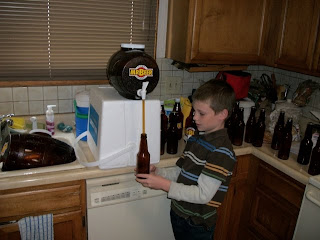Step 1: Sanitize the "Bottling Bucket" and the tubing using Star-San diluted in about a gallon of water. Also, pour a little sanitizer solution into a little bowl full of bottle caps and the tip of the bottling wand. Shake up the bucket to make sure every spot of the bucket is covered. Let everything sit in sanitizer for a few minutes.
 Step 2: Sanitize bottling wand and bottles by pouring Star San from bottling bucket into the bottles. I always use a combination of 1 liter bottles and 12 ounce bottles. Usually I aim for 3 liters bottles and 15 12 ounce bottles, but results can vary.
Step 2: Sanitize bottling wand and bottles by pouring Star San from bottling bucket into the bottles. I always use a combination of 1 liter bottles and 12 ounce bottles. Usually I aim for 3 liters bottles and 15 12 ounce bottles, but results can vary.
Step 3: All the bottles are filled, covered with a cap and shaken. Let them sit for awhile while placing the bottling wand and tubing onto the spigot of the full fermenter.

Step 4: Measure out priming sugar. In this case, we are going with 2 1/4 ounces.

Step 5: Boil the sugar in about 1 cup of water. Take off the heat and let cool. While the sugar water solution is cooling, pour the sanitizer from the bottles back into the gallon container to be used again.
Step 6: After the sugar / water solution has cooled, put the solution into the bottling bucket and let the beer from the fermenter drain through the bottling wand with tubing attached into the bottling bucket. IMPORTANT: MAKE SURE THE spigot of the bottling bucket is CLOSED before doing this. Don't ask how I know this is a potential issue. Let's just say that thanks to alert assistant brewers, the loss was minimal.
 Step 7: Wash and re-sanitize wand. Not sure this is 100% necessary, but certainly doesn't hurt.
Step 7: Wash and re-sanitize wand. Not sure this is 100% necessary, but certainly doesn't hurt.Step 8: Place the bottling tip on the wand and fill all the bottles. Let liquid get to the top of the bottle, and the displacement from the wand will leave the exact perfect amount of head space.

You have to let the smaller brewing assistant get his turn too. As each bottle is filled, place a top on it, but do use bottle capper until the very end.

Step 9: Attach the bottle caps to the 12 oz bottles with bottle capper.
 Step 10: Place all the bottles in a Styrofoam cooler and move to the basement. Let the bottles carbonate for 2 weeks.
Step 10: Place all the bottles in a Styrofoam cooler and move to the basement. Let the bottles carbonate for 2 weeks.After 2 weeks, the bottles will move to a conditioning cooler for 2 to 4 weeks and then to the beer fridge. I should be able to drink this beer around mid-December, but will probably keep some on hand for several months.






